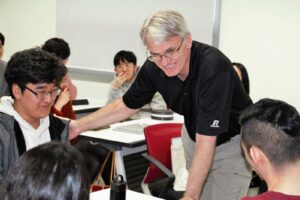 South Korea may be 6,000 miles from Salt Lake City, but students at the University of Utah’s Asia Campus (UAC) in Incheon can now go through the same rigorous and comprehensive civil engineering program there as they do on the U’s main campus in Utah.
South Korea may be 6,000 miles from Salt Lake City, but students at the University of Utah’s Asia Campus (UAC) in Incheon can now go through the same rigorous and comprehensive civil engineering program there as they do on the U’s main campus in Utah.
Earlier this year, the U’s College of Engineering and the Department of Civil and Environmental Engineering launched their undergraduate curriculum at the UAC to train the next generation of engineers on a global scale. Currently, about 20 students at the Asia Campus are enrolled in the CVEEN program.
“Such engineers are sorely needed to meet the challenges caused by rapid urbanization, climate change, and infrastructure renewal,” said U civil and environmental engineering associate professor Steven Bartlett (pictured with students), who began teaching on the Asia Campus in February. “We need to continue our educational efforts to prepare such engineers, and the greater Seoul metropolitan area offers an excellent living-learning laboratory. This area is rapidly developing with many ongoing infrastructure projects.”
The core curriculum at the Asia Campus, like the one in Salt Lake City, includes classes in engineering calculus, transportation, engineering economics, strength of materials, dynamics, general chemistry and more. And similar to the program in Salt Lake City, students at the UAC take 126.5 credit hours to earn the degree. The curriculum also offers a study-abroad program that can benefit both students in Utah and the UAC. Students in South Korea must attend the Salt Lake City campus during the second semester of their junior year and the first semester of their senior year to use the labs here, and students from the Salt Lake City campus have the opportunity to study at the UAC up to one academic year and pay resident tuition rates. Housing costs in South Korea are partially paid for by the Incheon Global Campus, which the UAC is part of. Student housing cost there varies between $900 to $1,300 per semester.
“The opportunity for academic and global exchange will enrich the educational and cultural experience of both student bodies,” Bartlett said. “In the future, I would hope that more U.S. students will take advantage and come to the UAC to learn with our Korean students. I believe this educational, technical and cultural exchange will strengthen the program on both campuses.”
U civil and environmental engineering chair Michael Barber said he began working on the South Korea program two years ago so students can learn about engineering’s global reach.
“It works as a two-way street where we [Utah students] can expand our own global footprint, and they [students in South Korea] can come here to interact with the Utah students and expand their horizon,” he said. Barber said he will hire a second instructor to teach at the UAC and hopes to have five faculty members there in five years.
He added that the partnership with South Korea was especially ideal because of that country’s move toward creating “smart cities,” urban areas that implement communication and information technologies, including the Internet of Things, to help manage the infrastructure.
“They already have three different communities in the area near our campus where they emphasize this, and it will be easy to bring in guest lecturers and real-life projects that highlight the smart-city concept,” Barber said.
The University of Utah Asia Campus launched in 2014 and now has undergraduate programs in communication, psychology, film and media arts, and urban ecology, as well as in civil and environmental engineering. It also has master’s programs in public health and biomedical informatics.